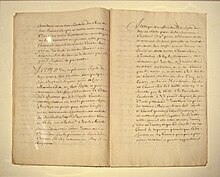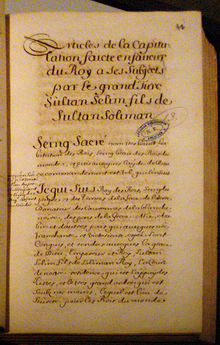From Wikipedia, the free encyclopedia
Capitulations of the Ottoman Empire were contracts between the Ottoman Empire and European powers, particularly France. Turkish capitulations, or ahdnames, were generally bilateral acts whereby definite arrangements were entered into by each contracting party towards the other, not mere concessions.[1]
The Turkish Capitulations were grants made by successive Sultans to Christian nations, conferring rights and privileges in favor of their subjects resident or trading in the Ottoman dominions, following the policy towards European states of the Byzantine Empire.
Contents |
History
France had already signed a first treaty or Capitulations with the Mamluk Sultanate in Cairo in 1500, during the rule of Louis XII,[2][3] in which the Sultan of Egypt had made concessions to the French and the Catalans. This treaty was upheld by the Ottoman Empire when the later captured the Mamluk Sultanate in 1517, following the Ottoman–Mamluk War (1516–1517).
Draft of the 1536 Treaty or Capitulations negotiated between French ambassador Jean de La Forêt and Ibrahim Pasha, a few days before his assassination, expanding to the whole Ottoman Empire the privileges received in Egypt from the Mamluks before 1518.
Other French kings down to Louis XV followed the same policy, which, whatever criticism it merits, was favourable to Christianity in the Levant; by zealously defending Christian interests at the Porte, they hoped to excuse their alliance with infidels, which was a source of scandal even in France. As early as 1528, Francis I had appealed to Suleiman the Magnificent to restore to the Christians of Jerusalem a church which the Turks had converted into a mosque. The Sultan refused on the grounds that his religion would not permit alteration of the purpose of a mosque, but he promised to maintain the Christians in possession of all the other places occupied by them and to defend them against all oppression.
However, religion was not the object of a formal convention between France and the Ottoman Empire prior to 1604, when Henry IV of France secured from Ahmad I the insertion, in the capitulations of 20 May, of two clauses relative to the protection of pilgrims and of the religious in charge of the church of the Holy Sepulchre. The following are the relevant clauses of the treaty: "Article IV. We also desire and command that the subjects of the said Emperor [sic] of France, and those of the princes who are his friends and allies, may be free to visit the Holy Places of Jerusalem, and no one shall attempt to prevent them nor do them injury"; "Article V. Moreover, for the honour and friendship of this Emperor, we desire that the religious living in Jerusalem and serving the church of Comane [the Resurrection] may dwell there, come and go without let or hindrance, and be well received, protected, assisted, and helped in consideration of the above." It is noteworthy that the same advantages are stipulated for the French and for the friends and allies of France, but for the latter in consideration of, and at the recommendation of France.

Capitulation reopenning trade between Venice and the Ottoman Empire signed 2 October 1540, following the Battle of Preveza.
During the reign of Louis XIV, the missionaries multiplied and extended the field of their activities. Due to his support, the often precarious tolerance on which the existence of the missions had depended, was officially recognized in 1673 when on 5 June, Mehmed IV not only confirmed the earlier capitulations guaranteeing the safety of pilgrims and the religious guardians of the Holy Sepulchre, but signed four new articles, all beneficial to the missionaries. The first decreed in a general manner "that all bishops or other religious of the Latin sect [cfr. Millet (Ottoman Empire)] who are subjects of France, whatever their condition, shall be throughout our empire as they have been hitherto, and [may] there perform their functions, and no one shall trouble or hinder them"; the others secure the tranquil possession of their churches, explicitly to the Jesuits and Capuchins, and in general "to the French at Smyrna, Saïd, Alexandria, and in all other ports of the Ottoman Empire".
The reign of Louis XIV marked the apogee of the French Protectorate in the East, for not only the Latin missionaries of all nationalities, but also the heads of all Catholic communities, regardless of rite or nationality, appealed to the Grand Roi, and at the recommendation of his ambassadors and consuls to the Porte and the pashas, obtained protection from their enemies. Though the missionaries were sometimes on such amicable terms with the non-Catholic clergy that the latter authorized them to preach in their churches, relations between the various Christian churches were usually very strained. On several occasions the Greek and Armenian non-uniate patriarchs, displeased at seeing a great portion of their flocks abandon them for the Roman priests, persuaded the Turkish Government on various pretexts to forbid all proselytization by the latter, but representatives of Louis XIV successfully opposed this ill-will.
At the beginning of the reign of Louis XV the preponderance of French influence with the Porte was also manifested in the authority granted the Franciscans, who were protégés of France, to repair the dome of the Holy Sepulchre; this meant the recognition of their right of proprietorship in the Holy Sepulchre as superior to the claims of the Greeks and the Armenians.
In 1723 the Eastern patriarchs succeeded in obtaining from the Sultan a firman (decree) forbidding his Christian subjects to embrace the Roman religion, and prohibiting Latin religious from having any communication with the Greeks, Armenians and Syrians on the pretext of instructing them. French diplomacy sought, long in vain, to have this measure revoked. At last, as a reward for the services rendered to Turkey during its wars with Russia and Austria (1736-9), the French succeeded in 1740 in securing the renewal of the capitulations, with additions which explicitly confirmed the right of the French Protectorate, and at least implicitly guaranteed the liberty of the Catholic apostolate. By the eighty-seventh of the articles signed on 28 May 1740, Sultan Mahmud I declared: "... The bishops and religious subject to the Emperor of France living in my empire shall be protected while they confine themselves to the exercise of their office, and no one may prevent them from practising their rite according to their custom in the churches in their possession, as well as in the other places they inhabit; and, when our tributary subjects and the French hold intercourse for purposes of selling, buying, and other business, no one may molest them for this sake in violation of the sacred laws."
In subsequent treaties between France and Turkey, the capitulations were not repeated verbatim, but they are recalled and confirmed (e. g. in 1802 and 1838). The various regimes which succeeded the monarchy of St. Louis and of Louis XIV all maintained in law, and in fact, the ancient privilege of France in the protection of the missionaries and Christian communities of the Orient. The expedition in 1860 sent by Emperor Napoleon III to put a stop to the massacre of the Maronites was in harmony with the ancient rôle of France, and would have been more so if its work of justice had been more complete. The ultimate decline of the French Protectorate in the Levant will be treated below.
Status
Capitulations signified that which was arranged under distinct headings; the Ottoman Turkish phrase was ahid nameh, whereas a "treaty" was mouahed. The latter did, and the former did not, signify a reciprocal engagement.[citation needed]According to Capitulations, and treaties confirmatory of them, made between the Porte and other states, foreigners resident in Turkey were subject to the laws of their respective countries, i.e., the various non-Muslim peoples were allowed their semi-autonomy in matters affecting their personal status.
Thus, although the Turkish capitulations were not in themselves treaties, yet by subsequent confirmation they acquired the force of commercial durable instead of personal nature; the conversion of permissive into perfect rights; questions as to contraband and neutral trade stated in definite terms.
Abolition
As far as Turkey is concerned, the capitulations were abolished by the Treaty of Lausanne (1923), specifically by Article 28:- Each of the High Contracting Parties hereby accepts, in so far as it is concerned, the complete abolition of the Capitulations in Turkey in every respect.[4]
